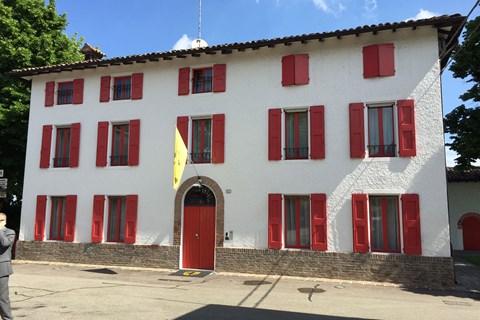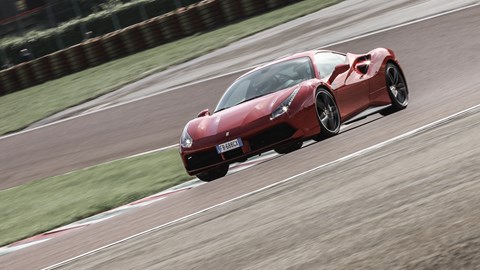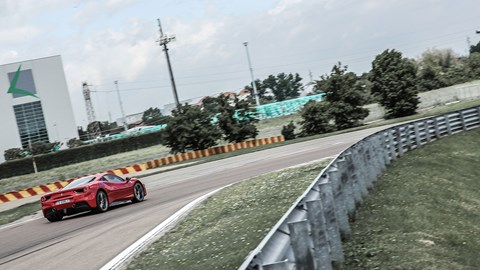► What makes Fiorano special?
► CAR visits – and drives – the circuit
► Every Ferrari, road and race, is developed here
Gilles was here. And Lauda, Forghieri, Alesi, Brawn… There’s history oozing from every well-manicured surface at Ferrari’s Fiorano test centre.
Now we’re here too, stopping off at Fiorano during a visit to Maranello. The figure-of-eight circuit, coiled into overlapping adjacent fields acquired by Enzo Ferrari many years ago, is a stone’s throw from Ferrari’s ever-growing factory. It’s become a very big place, Ferrari’s plant, generating its own off-grid power and dominating an otherwise quiet, industrial town mostly populated by ceramic tile companies, and countless souvenir shops selling objects with a picture of a horse on them. It must be an odd place to live if you don’t work for Ferrari.

La Pista di Fiorano is right next door, handily close to the brand-new building dedicated to Ferrari’s F1 team. Making his beloved Grand Prix cars go faster was at the forefront of Enzo Ferrari’s mind when he commissioned the track’s construction for 1972. His old quarters still stand in the midst of the circuit, next to the original converted farm buildings used as garages all those years ago, and a stone’s throw from the modern air-conditioned pits.
Inside Enzo’s old pad, his office has been left virtually untouched, right down to the black and white television on which he used to watch Grands Prix after he stopped attended the races personally. It’s a surreal tableau, almost like a film set. A cluster of chairs sit around the (very tidy) desk, as if ready for a meeting. It’s not difficult to imagine the intimidation factor emanating from the shades on the other side of the desk.

Back in the days of virtually endless F1 testing, Michael Schumacher used to stay in the house regularly. It says everything about how much autonomy he was allowed at Ferrari that he converted the top floor into a gym, including a hydraulic rig to train his neck muscles. In the evenings, he’d play football out front with some of the team. ‘With the greatest respect to the drivers of today,’ a Ferrari insider told us, ‘ you can’t imagine Kimi doing that.’
These days, the house provides overnight accommodation for some of Ferrari’s important clients. Or simply well-heeled fans – for a few thousand Euros it’s possible to stay in Old Man Ferrari’s former gaff for the night. Which in some ways feels a little sad – is there anything at Ferrari that isn’t for sale?
Since F1’s present tight testing restrictions came into force, Fiorano no longer reverberates to the metronomic testing of Grand Prix cars. But there’s still plenty of development work going on here; all of Ferrari’s road cars, track-only FXX creations, and ex-F1 Corse Clienti machines rack up lap of lap of test and training miles.
A sprinkler system enables Ferrari to wet the entire circuit, and there’s an enormous steering pad. Ferrari’s squad of development drivers are part-racing driver, part-engineer hybrids (with a penchant for designer sunglasses), talking in dizzyingly complex terms about coefficients of friction and centres of pressure.

We hitch a ride with tyre development driver Fabrizio in a 488 GTB, chatting away as he deftly powerslides from corner to corner. An engineer by background, his job includes developing Ferrari’s one-make 488 Challenge race cars and futuristic FXX track cars, as well as road cars such as the new F12 tdf and GTC4Lusso. ‘It’s more interesting to develop road cars than racing cars,’ he says, mid-drift – ‘racing cars need to be set up for maybe 12 tracks and two drivers. ‘Road cars need to be driven by all kinds of drivers, in all kinds of conditions in all kinds of markets. The challenge is greater.’ Fabrizio’s job is tyre development – it’s thanks to him and his colleagues that the 488 GTB’s alternative Michelins and Pirellis perform as identically as they possibly can in the same range of conditions, from freezing to baking, dry to soaking, and give the driver the same kind of feedback on the limit.
Which is hugely impressive; we swap seats with Fabrizio and find that thanks to its ‘side slip control’ software witchcraft (and inherently balanced chassis), the 488 is a mid-engined, turbocharged 660bhp car you can steer on the throttle like a 100cc kart. It’s magic. Holding a powerslide with a Ferrari development driver in the passenger seat murmuring ‘niiiiice’ approvingly is a moment I’ve cut out and framed in my mind’s eye forever. The electronic stability system is so unobtrusive it’s easy to forget it’s quietly working away in the background to keep the car out of Fiorano’s large-ish (but not that large) gravel traps.
Such systems seem only set to become more complex in the future; electronic control for dampers, brake intervention, even rear-wheel steering on some of Ferrari’s latest models, will continually evolve to make the company’s cars faster and friendlier to drive than ever. There certainly won’t be a Ferrari with passive dampers released in the near future. Does that future include an SUV? ‘Ferrari has never made a model more than 5m long,’ an engineering insider tells us, ‘and does not plan to.’
Each lap, we back off the throttle and coast after the final corner. Believe it or not, even Ferrari’s testing activities in its backyard at Maranello are subject to the creeping threat of noise complaints. There’s magic here, for sure, but there’s only so much it can do…
Six things you didn’t know about Ferrari’s Fiorano test centre
